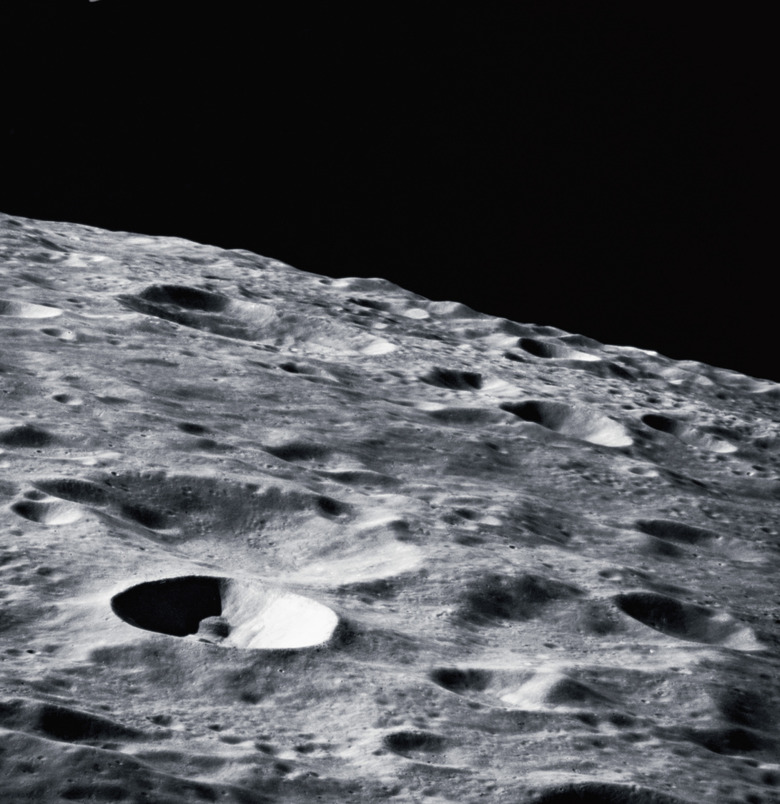Does The Moon Have Solar Wind Storms?
The moon experiences solar wind storms in a different way than Earth. The solar wind affects the entire solar system, but each body is affected differently, depending on its magnetic field. A magnetic field deflects the ionized particles of the solar wind, protecting a planet or moon from extreme solar wind storms. The moon does not have a uniform magnetic field, so it experiences intense solar wind storms. The sun's activity fluctuates on an 11-year cycle. At the peak of this cycle, it gives off more frequent solar flares and CMEs. During these solar peaks, therefore, the moon will experience more solar wind storms.
The Solar Wind
The Solar Wind
The solar wind is a stream of ionized gas, or plasma, ejected from the sun. The main components are individual protons and electrons, though it can also consist of ionized atoms of elements as heavy as iron. The solar wind is always traveling outward from the sun, but the stream itself varies in intensity. If there is a solar flare or a coronal mass ejection, or CME, the solar wind will be more intense. In these cases, the moon will be intensely bombarded by solar wind particles.
Magnetic Field
Magnetic Field
The moon does not have a magnetic field of nearly the same strength and uniformity as that of Earth. Earth's magnetic field concentrates bursts of solar wind in the polar regions. The moon, on the other hand, has only traces of a non-uniform magnetic field. Therefore, it is unable to deflect the solar wind in the same way the Earth does. In fact, scientists theorize that the solar wind helps strengthen certain aspects of the moon's magnetic field regions. When solar wind particles encounter this magnetic field, the resulting deflection pattern creates an electric charge. This resulting electric field reinforces the shielding properties of the magnetically active region.
The Lunar Surface
The Lunar Surface
The particles of the solar wind, upon reaching the lunar surface, can disturb the atoms in lunar dust. During a CME, the ions in the solar wind are heavier, and are capable of actually displacing loose lunar dust material upon collision with the moon's surface. Most of this displaced material is ejected into space. There, its molecules are broken down and it becomes ionized in the solar wind. In this sense, the moon's solar wind storms have a much more immediate surface effect than the storms that affect Earth. On Earth, the physical interactions are limited to the atmosphere and electromagnetic devices like radios and power grids.
Effects on Terrain
Effects on Terrain
The displaced dust from the lunar surface does not return to the moon after it is ejected into space. However, the moon regularly acquires new material from meteorites and other transient particles in space. Hence, the net result on the moon's mass due to lunar dust displacement is minimal. One visible effect on the moon's surface features is the contrast between regions where dust has been displaced and the regions shielded by a magnetic field. The regions under a magnetic field have a brighter layer of undisturbed dust. The regions in which dust has been displaced by the solar wind appear darker. Therefore, solar wind storms may actually produce some of the striking contrasts of brightness we see in the lunar surface features.
Cite This Article
MLA
Murmson, Serm. "Does The Moon Have Solar Wind Storms?" sciencing.com, https://www.sciencing.com/moon-solar-wind-storms-3746/. 24 April 2017.
APA
Murmson, Serm. (2017, April 24). Does The Moon Have Solar Wind Storms?. sciencing.com. Retrieved from https://www.sciencing.com/moon-solar-wind-storms-3746/
Chicago
Murmson, Serm. Does The Moon Have Solar Wind Storms? last modified March 24, 2022. https://www.sciencing.com/moon-solar-wind-storms-3746/
